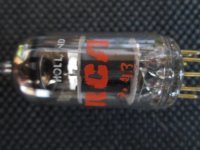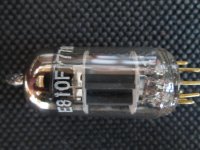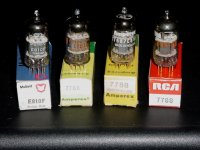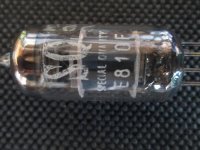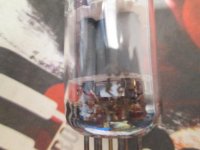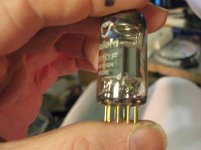Another photo of the E810F
HI ALL
Recently i bought a pair of E810F , but one of them looks a bit strange to me...it has marked E810F/7788 in one side and RCA and made in Holland in the other side...Rebranded or fake ?
Attachments
I would suspect real as well, I have a number of these and have not yet seen anyone counterfeiting these - I guess they are still obscure enough that no one has thought to pass off phonies for profit.
It may be a real E810F/7788 but I don't think RCA ever made that number. It isn't in any of their data books. Nor did any American manufacture. If it's from Holland it's probably Amperex. Phillips and Siemens also made them. I know the label is worn but it's still a sloppy job. Could have been done by one of the surplus resellers of days gone by. I could name names, but won't.
RCA did sell this tube, but did not actually make it. Manufactures around the world bought from each other. Then put their own brand on them which was perfectly legal. Notice the clean sharp lines on this "offical" RCA brand. Mullard also made them. Anyway, the 7788 is a very nice tube with lots of gain even in triode mode.
Attachments
Does Any one have some circuits for this tube as a triode? Or tried it out/
I have some E810f's to try out.
Thanks
Phil
I have some E810f's to try out.
Thanks
Phil
E810F
Hello! I had a look at my stock list, and found that these tubes had many manufacturers in europe. Miniwatt Dario RTC Mullard Philips Siemens Telefunken It's not surprising to see some of them rebranded by RCA. In europe, many RCA manufactured types were also rebranded with local brands. It was simply a bilateral commercial agreement. E810F were often used in oscilloscopes and other industrial equipments. By the way, in pentode mode, their gain is so huge that they are strongly prone to self oscillation. Use adequate design rules, even in triode mode, to avoid such bad surprises. For audio, E180F or 6J9P (Russian version) in triode mode SRPP really give fantastic results, and are much more stable and cheaper than E810F.
Hello! I had a look at my stock list, and found that these tubes had many manufacturers in europe. Miniwatt Dario RTC Mullard Philips Siemens Telefunken It's not surprising to see some of them rebranded by RCA. In europe, many RCA manufactured types were also rebranded with local brands. It was simply a bilateral commercial agreement. E810F were often used in oscilloscopes and other industrial equipments. By the way, in pentode mode, their gain is so huge that they are strongly prone to self oscillation. Use adequate design rules, even in triode mode, to avoid such bad surprises. For audio, E180F or 6J9P (Russian version) in triode mode SRPP really give fantastic results, and are much more stable and cheaper than E810F.
I think this tube can be used to amplify low signal levels, like phono RIAA preamplifiers. There you can take advantage of its low noise capability and high gain.
Does Any one have some circuits for this tube as a triode? Or tried it out/
I have some E810f's to try out.
Thanks
Phil
I use them as the first valve in an RIAA phono preamp. If you search the forum, you should be able to find the triode curves from a Mullard manual for this valve which I posted quite a while ago.
I think they were all made by Philips in Holland and rebranded by other companies, though I do have some in boxes which say they were made in USA. If they are Philips ones they should have a code printed on them in indelible ink on the lower half of the tube.
Both Mullard and Philips E810F I've got had etched on their base a Philips Heerlen - Holland code and in the old scopes I've seen just Philips made too.
Last edited:
There is a code there, but it is 39If you can find the code "d3" on the glass near the pins, it will be a Philips E810F.
2F
wich is maybe from another manufacturer than philips.
Hmm, that's a bit odd. Usually the Philips codes are two rows of three symbols, one indicating factory and date and the other the type and iteration, so for an E810F it would say d30, d32, etc. and actually there might be another code for E810F (no idea why).
All the info can be found at Mullard, Philips, and Valvo Tube Codes
and the lists are www.audiotubes.com/PhilipsCodeList.pdf
There is unfortunately no concordance relating valve types to codes.
Is it at all feasible to photograph the codes?
All the info can be found at Mullard, Philips, and Valvo Tube Codes
and the lists are www.audiotubes.com/PhilipsCodeList.pdf
There is unfortunately no concordance relating valve types to codes.
Is it at all feasible to photograph the codes?
Well, i tried to make some photos, but it is very difficult to see it clear, maybe my camera is not good enough to do the job, i will try tomorrow with daylight.Hmm, that's a bit odd. Usually the Philips codes are two rows of three symbols, one indicating factory and date and the other the type and iteration, so for an E810F it would say d30, d32, etc. and actually there might be another code for E810F (no idea why).
All the info can be found at Mullard, Philips, and Valvo Tube Codes
and the lists are www.audiotubes.com/PhilipsCodeList.pdf
There is unfortunately no concordance relating valve types to codes.
Is it at all feasible to photograph the codes?
Attachments
Well, i tried to make some photos, but it is very difficult to see it clear, maybe my camera is not good enough to do the job, i will try tomorrow with daylight.
Actually looking at your photo in blow-up, that does look like "d36" to me. Most of mine are marked "d36" (though quite a lot are not marked at all).
- Status
- Not open for further replies.
- Home
- Amplifiers
- Tubes / Valves
- IS THIS A REAL E810F ???


